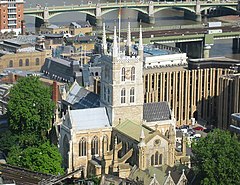
Back Southwark Afrikaans سودرك Arabic ساذارك ARZ ساتارک AZB Southwark Welsh Southwark (kvartalo) Esperanto Southwark Estonian ساتارک Persian Southwark Finnish Southwark (quartier) French
| Southwark | |
|---|---|
 Southwark Cathedral, also called St Saviour's, for centuries known as St Mary's Overy, or Overie (short for "over-the-river") | |
Location within Greater London | |
| OS grid reference | TQ325795 |
| • Charing Cross | 1.5 mi (2.4 km) W |
| London borough | |
| Ceremonial county | Greater London |
| Region | |
| Country | England |
| Sovereign state | United Kingdom |
| Post town | LONDON |
| Postcode district | SE1 |
| Dialling code | 020 |
| Police | Metropolitan |
| Fire | London |
| Ambulance | London |
| UK Parliament | |
| London Assembly | |
Southwark (/ˈsʌðərk/ ⓘ SUDH-ərk)[1] is a district of Central London situated on the south bank of the River Thames, forming the north-western part of the wider modern London Borough of Southwark. The district, which is the oldest part of South London, developed due to its position at the southern end of the early versions of London Bridge, for centuries the only dry crossing on the river. Around 43 AD, engineers of the Roman Empire found the geographic features of the south bank here suitable for the placement and construction of the first bridge.
London's historic core, the City of London, lay north of the bridge and for centuries the area of Southwark just south of the bridge was partially governed by the City, while other areas of the district were more loosely governed. The section known as Liberty of the Clink became a place of entertainment. By the 12th century Southwark had been incorporated as an ancient borough, and this historic status is reflected in the alternative name of the area, as Borough. The ancient borough of Southwark's river frontage extended from the modern borough boundary, just to the west of the Oxo Tower, to St Saviour's Dock (originally the mouth of the River Neckinger) in the east. In the 16th century, parts of Southwark near London Bridge became a formal City ward, Bridge Without.
The urban area expanded over the years and Southwark was completely separated administratively from the City in 1900. Local points of interest include Southwark Cathedral, Borough Market, Shakespeare's Globe theatre, The Shard, Tower Bridge, Butler's Wharf and the Tate Modern museum.
- ^ "Southwark". The Columbia Lippincott Gazetteer of the World. New York: Columbia University Press. 1952.
